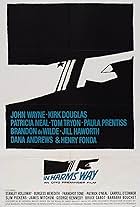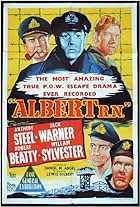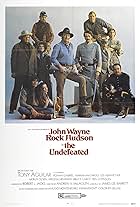During the early Pacific war years, American seaman George Tweed is the only U.S. serviceman on Guam not captured by the Japanese forces.During the early Pacific war years, American seaman George Tweed is the only U.S. serviceman on Guam not captured by the Japanese forces.During the early Pacific war years, American seaman George Tweed is the only U.S. serviceman on Guam not captured by the Japanese forces.
- Directors
- Writers
- Stars
Chichay
- Mrs. Nakamura
- (as Amparo [Chichay] Custodio)
Bert Lafortaza
- Comdr. Oto Harada
- (as Bert Laforteza)
- Directors
- Writers
- All cast & crew
- Production, box office & more at IMDbPro
Featured reviews
During the early Pacific war years , the Japanese invade island of Guam , as seaman Tweed and his colleagues attempt to escape . Little by little the American seaman named George Tweed : Jeffrey Hunter , becomes the only serviceman living in Guam and being mercilessly pursued by the Japanese during the early years of World War II . He is befriended by some of the islanders and assisting him in the evading and traveling to a secure place . Step by step he saves his life and remains in hiding there until the US Navy goes back providing information enough about bases and gun locations .
This classic warlike movie based on the true story of George Tweed, an American sailor , well played by Jeffrey Hunter , who became the only serviceman on the island of Guam to avoid his capture and along the way delivering targets to an American destroyer when it approaches by contacting them to warn them of shore artillery . This soldier was nicely starred by Jeffrey Hunter at one of his best and unknown roles as a two-fisted soldier George Tweed , an American Sailor from Minneapolis stationed on Pre-war Guam at a radio relay station , he's well accompanied by a plethora of sympathetic secondaries , all of them form the small group of charming actors endeavouring to flee from cruel Japanese army . Stirring actioner/drama warfare completed with slice of military stereotypes although some characters are very one-dimensional . Adding a romantic relationship developing between Tweed/Hunter and the daughter of his benefactor , the attractive Barbara Perez . This agreeable wartime saga results to be a a good film dealing with war in human terms . Here directors have a sensitive handling of actors and provide an exact compositional sense . Two filmmakers handle in all -especially human relation scenes as well as battle set pieces - with flair play and vigour . There is a fair bit of flag-waving and patriotism , but that was just what was needed when the picture was made . It may not be an awesome film , but this is a sensitive and well made war epic . This colorful movie contains action , breathtaking battles , thrills , historical events , romance , and the battle scenes are impressively made with special mention at the end as our starring is besieged on the beach while attempting to be taken aboard ship . Stalwart main cast , Jeffrey Hunter along with a minor acting by Marshall Thompson , both of whom provide splendid interpretations . Being stunningly supported by a large plethora of Philippine actors , mainly the beautiful eye-catching Barbara Perez , Ronald Remy , among others , and all the Philippine supporting actors spoke Tagalog rather than Chamorro . The film is set into a lush , abundant jungle , shot entirely in the Philippines, with nice cinematography in technicolor by Carl Kayser , though a perfect remastering being extremely necessary. The film though set in Guam was completely filmed in Tamaraw Studios, Metro Manila, Philippines and Universal Studios 100 Universal City Plaza, Universal City, California . Being freely based on the 1945 book "Robinson Crusoe, USN" by George Ray Tweed and script by Richard Goldstone and John Monks Jr. who produced and directed , as well. This filmmakers were notorious producers and writers , though directed a few movies .
This ¨No man in an island¨ is one of a handful of feature films that have featured the story of the World War II , set in Philippines or others Pacific Islands , many of them revolving Battle of Bataan or dealing with American soldiers supporting native Guerrillas , they include as follows : ¨Bataan¨ (1943) by Tay Garnett with Robert Taylor , ¨So proudly we hail ¡¨ by Mark Sandrich (1943) , ¨They were expendable¨ (1945) by John Ford with John Wayne , ¨Back to Bataan¨(1945) by Edward Dmytryck with John Wayne , Anthony Quinn , Beulah Bondi and ¨American Guerrilla in Philippines¨ (1950) by Fritz Lang with Tyrone Power , Micheline Presle , Robert Patten, Tom Ewell .
This classic warlike movie based on the true story of George Tweed, an American sailor , well played by Jeffrey Hunter , who became the only serviceman on the island of Guam to avoid his capture and along the way delivering targets to an American destroyer when it approaches by contacting them to warn them of shore artillery . This soldier was nicely starred by Jeffrey Hunter at one of his best and unknown roles as a two-fisted soldier George Tweed , an American Sailor from Minneapolis stationed on Pre-war Guam at a radio relay station , he's well accompanied by a plethora of sympathetic secondaries , all of them form the small group of charming actors endeavouring to flee from cruel Japanese army . Stirring actioner/drama warfare completed with slice of military stereotypes although some characters are very one-dimensional . Adding a romantic relationship developing between Tweed/Hunter and the daughter of his benefactor , the attractive Barbara Perez . This agreeable wartime saga results to be a a good film dealing with war in human terms . Here directors have a sensitive handling of actors and provide an exact compositional sense . Two filmmakers handle in all -especially human relation scenes as well as battle set pieces - with flair play and vigour . There is a fair bit of flag-waving and patriotism , but that was just what was needed when the picture was made . It may not be an awesome film , but this is a sensitive and well made war epic . This colorful movie contains action , breathtaking battles , thrills , historical events , romance , and the battle scenes are impressively made with special mention at the end as our starring is besieged on the beach while attempting to be taken aboard ship . Stalwart main cast , Jeffrey Hunter along with a minor acting by Marshall Thompson , both of whom provide splendid interpretations . Being stunningly supported by a large plethora of Philippine actors , mainly the beautiful eye-catching Barbara Perez , Ronald Remy , among others , and all the Philippine supporting actors spoke Tagalog rather than Chamorro . The film is set into a lush , abundant jungle , shot entirely in the Philippines, with nice cinematography in technicolor by Carl Kayser , though a perfect remastering being extremely necessary. The film though set in Guam was completely filmed in Tamaraw Studios, Metro Manila, Philippines and Universal Studios 100 Universal City Plaza, Universal City, California . Being freely based on the 1945 book "Robinson Crusoe, USN" by George Ray Tweed and script by Richard Goldstone and John Monks Jr. who produced and directed , as well. This filmmakers were notorious producers and writers , though directed a few movies .
This ¨No man in an island¨ is one of a handful of feature films that have featured the story of the World War II , set in Philippines or others Pacific Islands , many of them revolving Battle of Bataan or dealing with American soldiers supporting native Guerrillas , they include as follows : ¨Bataan¨ (1943) by Tay Garnett with Robert Taylor , ¨So proudly we hail ¡¨ by Mark Sandrich (1943) , ¨They were expendable¨ (1945) by John Ford with John Wayne , ¨Back to Bataan¨(1945) by Edward Dmytryck with John Wayne , Anthony Quinn , Beulah Bondi and ¨American Guerrilla in Philippines¨ (1950) by Fritz Lang with Tyrone Power , Micheline Presle , Robert Patten, Tom Ewell .
This is an excellent war movie based on a true story. The action is great, and the characters very identifiable. There is one really mean character, but his character does ring true for the times, and he reveals a prejudice that was present. In fact, as a historical adventure based on true events, certain liberties are taken to show higher truths. That is what this movie does. Characters will often be composites to show the events in a condensed version. Otherwise, the movie would be forty hours long. This movie centralizes on Tweed and four other Americans trying to escape occupied Japanese territory. They are aided by natives, and that is what the movie is about. Modern audiences won't like the fact that Tweed is a likable character. One of the advantages of older movies is that they didn't present all lead characters as ridiculous stereotypes and homicidal maniacs. Also, some puritans insist that every action be historically beyond doubt. To read some of the reviews here, you would think that they couldn't show Tweed eating rice without having a receipt for the rice in the Smithsonian Institute. Just enjoy a well done movie with great actors. Remember, who did the studio get to play the son of God in a later movie?
If you read the book, four guys decide not to surrender. The Japanese knew about them and were absolutely ruthless. Killing the native Chamorros ruthlessly and brutally. Many of the natives gave their lives and did not give away where they were hidden.
Three of the soldiers thought they'd sleep and some kind of native Hut and native turn them in because his whole family was threatened. Man there's no easy answers here.
George Tweed held out to the end and it was a destroyer that picked him up not a submarine.
He also use Semaphore Flags, which are very hard to use. More difficult than Morse code. To communicate to the Destroyer that picked him up. Read the book and watch the movie.
Three of the soldiers thought they'd sleep and some kind of native Hut and native turn them in because his whole family was threatened. Man there's no easy answers here.
George Tweed held out to the end and it was a destroyer that picked him up not a submarine.
He also use Semaphore Flags, which are very hard to use. More difficult than Morse code. To communicate to the Destroyer that picked him up. Read the book and watch the movie.
Given that movies in the 50s and 60s were never meant to show the true life "grittiness" of war that we see in movies made today such as Saving Private Ryan, I was more turned off by the lack of truth to the story. As many others have said here, it's a great story worthy of a big budget production. I lived on Guam while in the Navy, and actually had the opportunity to go to what is called "Tweed's cave". Which by the way is located in the Northwest corner of the island on the Navy's Communnication station property. It's well worth the hike because you really get a sense of the life Tweed led in those 18month's. Watch the movie for it's own sake and not for the truthfulness of the story line.
Jeffrey Hunter plays the part of George Tweed, the redoubtable U.S. Navy radioman who survived in hiding on Guam during the Japanese occupation of that island, with the assistance of many Guamanians who willingly turned their lives upside-down to protect him. Hunter is woefully miscast; devout Antonio Antero, the Chamorro who was Tweed's principal benefactor during his ordeal, was convinced of his Christian duty to assist the American due to the latter's appearance: gaunt and dirty with long hair and sullied clothing, akin to Christ before the crucifixion, but Hunter is obviously well-nourished with his hair style never disturbed, and with barely a nod by his demeanor to his taxing situation. Tweed, as the sole American survivor of the invasion, was a totem to the people native to Guam that the United States was still there, but this fact is overlooked in this production. Although Tweed was hidden within a cave in the island's southeast, a popular tourist attraction today, the scenario places him atop a mountain where he would be in plain view of enemy aircraft, a serious miscue in light of the fact that much of the occupiers' activity was revolving about attempts at his capture. Tweed cleverly repaired a damaged radio and typewriter and through skillful use of both helped to offset Japanese propaganda concerning the true progress of the war; however, this is touched on but briefly and in a distorted fashion, at that. Although obviously designed as packaged Hollywood entertainment, the screen story appears jejune when one recalls that many died to preserve the safety of the real-life Tweed. Filmed in the Philippines with largely local performers, NO MAN IS AN ISLAND flags from consistently poor production characteristics, which tend to jar a viewer's sensibilities. Not surprisingly, the acting is variable, with Marshall Thompson being wasted, and Hunter swallowing many of his lines as well as being uncomfortably saddled with a vapid love interest. Since the script does not delineate a point of view, and there is scant in the way of direction, we are left with one cliché-ridden scene after another. Some potentially engaging sub-plots, in particular one formed from the plight of Japanese-Americans remaining on Guam during the occupation, are only grazed fragments here. Talented Basil Wrangell does his best at editing this affair, but his cachet is finally defeated as the movie flounders forward to its hackneyed conclusion.
Did you know
- TriviaThe story is based on true events. The real George Tweed died in 1989.
- GoofsAfter Mr. Shimoda dies (1:23:29), thieves open his buried coffin and steal his body. This wouldn't have been possible since Mr.Shimoda, like most Japanese Buddhists, would have been cremated the day after the wake. After the cremation, his mourners would have picked his bones out of the ashes with chopsticks, and the ashes would have been transferred to a large funeral urn.
- ConnectionsReferenced in To Tell the Truth: Tom Poston, Peggy Cass, Gene Rayburn, Kitty Carlisle (1962)
- How long is No Man Is an Island?Powered by Alexa
Details
- Runtime1 hour 54 minutes
- Aspect ratio
- 1.85 : 1
Contribute to this page
Suggest an edit or add missing content























